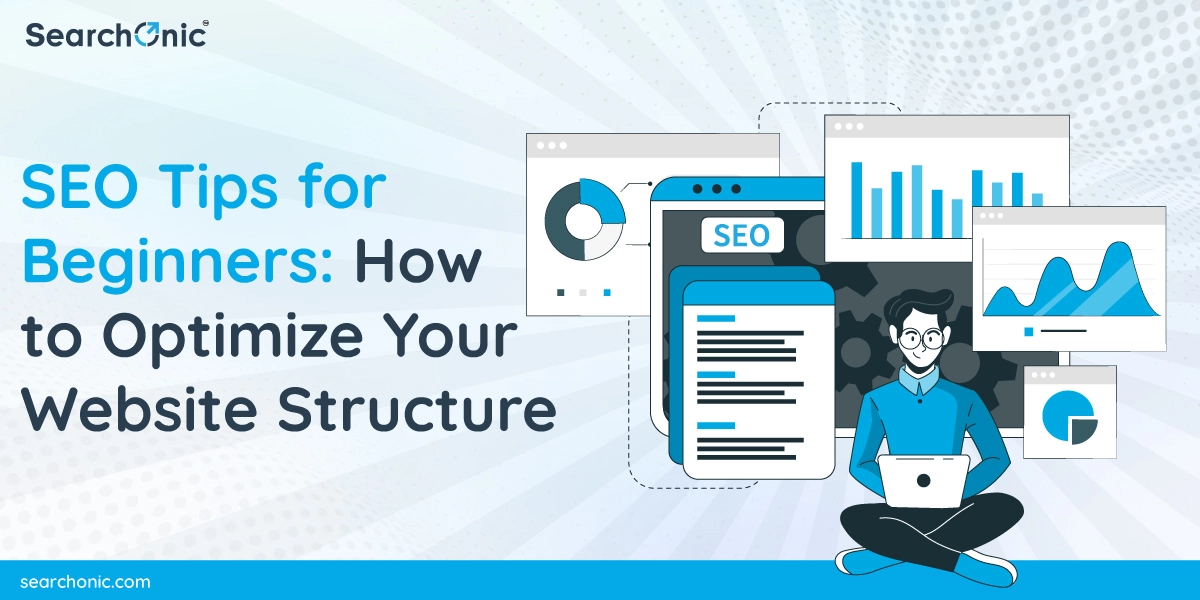SEO Tips for Beginners: How to Optimize Your Website Structure
SEO Tips for Beginners: How to Optimize Your Website Structure
Search Engine Optimization (SEO) is a vital stage in the process of making your website more easily found on the web. Another important factor of SEO that is usually ignored but should be taken into consideration is the location of your site.
The organization of your website influences how search engine robots explore and catalog your individual articles (posts). In this blog, you will get SEO tips for beginners on how to organize your site most effectively, with a major emphasis on Enterprise SEO Services for improving the rankings of business websites.
Understanding Website Structure
The framework of a website refers to how the webpages are organized and interlinked with each other. It is also important to understand that structuring of ones website in a well ordered manner helps the users and the search engines in navigating through the content effectively.
Importance of a Well-Organized Website
Website organization further improves the usability since it helps the user to locate relevant information within a short time. This results in longer bounce rates and visits and both of these improve your SEO rankings and standards.
How Website Structure Affects SEO
One of the benefits of having a clear and structured layout is that these ‘crawlers’ are able to quickly and easily index your content, leading to increased search engine optimization and ranking.
Planning Your Website Structure
Define Your Goals
● Identify the Purpose of Your Website
However, as a first step toward designing the general architecture of a site, it is first necessary to determine the major goal of the site. Whether you own an e-commerce site, a blog, or a service site, understanding the best SEO tips for beginners will help determine the construction of the site.
● Determine Your Target Audience
Getting to know your target market puts you in a good position to follow a structure that fluids. Think about what kind of material they need and how they would like to search through your Website.
Create a Sitemap
● What is a Sitemap?
A sitemap is a special document that contains information about all the Website pages on the respective site. A well-organized website structure (framework) aids search engines in grasping the hierarchy and relationships within your content.
● Importance of a Sitemap for SEO
Sitemaps are crucial for SEO because they guide search engines to all your important pages, ensuring nothing is overlooked during the indexing process. Think of Googlebot as a web crawler exploring your site. A sitemap acts like a handy map, helping it find all the Important corners, especially on large or complex websites.
● Tools to Create a Sitemap
Several tools can help you create a sitemap, such as Yoast SEO for WordPress, Screaming Frog, and XML-Sitemaps.com. These programs streamline the creation process. Moreover, they guarantee your sitemap adheres to the proper format that search engines understand.
URL Structure
Keep URLs Simple and Descriptive
● Use Keywords in URLs
Seo tips and tricks for beginners boost the prominence of search engine results. This practice also clarifies the webpage’s content.
● Avoid Special Characters and Numbers
While they might seem clever, these unique characters in your website addresses are actually very confusing. Furthermore, even numbers complicate the URL. For better readability and memorability, stick to using letters. Lastly, you can also use hyphens to clearly communicate the webpage’s content.

Use Hyphens to Separate Words
● Importance of Readability
Separating words in your website addresses (URLs) with hyphens makes them easier to understand for users. This practice improves clarity and prevents search engines from misinterpreting the structure of your URLs.
● Example of Good vs. Bad URLs
Imagine your website as a store. Good links are like positive recommendations from trusted sources, bringing more customers through the door (higher rankings). Bad links are like spam flyers - they hurt your reputation and keep customers away.
Good URL: www.example.com/seo-tips
Bad URL: www.example.com/seo_tips_123
Organizing Content with Categories and Tags
Use Clear Categories
● How to Create Effective Categories
Categories should be broad topics that cover multiple pieces of content. These elements (categories/tags) act as signposts, guiding users and search engines towards the core topics and content covered on your website.
● Importance of Categories for User Navigation
Clear categories group the related content together. Effective website navigation serves a critical role in fostering an intuitive user experience. It streamlines information discovery, allowing visitors to locate desired content expeditiously. A well-designed navigation system doesn’t just make visitors happy; it also makes your website function smoother and easier to use.
Implement Relevant Tags
● Difference Between Categories and Tags
Think of categories like filing cabinets for your website content. They hold large groups of related articles or information. Tags, on the other hand, are like individual labels on those files. They pinpoint the specific details of each post. Both help organize your content but serve different purposes.
● Best Practices for Tagging Content
Use tags to highlight specific topics within your categories. Beyond labeling content by topic, tags can also categorize format. This lets users find specific content types, like articles, infographics, or videos. Marketers can use tags like “white paper” or “case study” to help users discover valuable resources. By using a clear tagging system, you can analyze which formats resonate with your audience and tailor your content strategy accordingly.
Internal Linking Strategy
How Internal Links Benefit SEO
Think of your website as a web. Internal links are the threads that tie the pages together. By linking related content, you create a clear path for search engines to follow and understand the connections between different subjects on your site. They also distribute page authority and improve user navigation.
Examples of Effective Internal Linking
Linking from high-traffic pages to those you want to boost can effectively distribute link equity across your site. 36% businesses find link building so important they hire professionals. Even in the future, 92% marketers believe links will stay a key factor for ranking high in search results.
Best Practices for Internal Linking
● Use Descriptive Anchor Text
The clickable text (anchor text) for your links should be clear and descriptive. This is a preview of the linked page.
● Link to Relevant Content
Keep your links relevant! If you use random connections or random links, users will get lost, and search engines might penalize you for using them. Instead, focus on linking to high-quality sources that provide valuable additional information to your readers and expand on the topic at hand.
● Maintain a Reasonable Number of Links
Don’t turn your pages into linkfests! While including links can be helpful, bombarding users with too many can be overwhelming. Prioritize high-quality connections that genuinely enhance the content for your readers rather than just stuffing in every possible link you can find.
Mobile-Friendly Design
Importance of Mobile Optimization
Mobile users expect fast, responsive websites. Over half, around 61% of shoppers prefer websites that offer a smooth experience on smartphones. Turn mobile browsers into happy buyers!
● Impact of Mobile-Friendliness on SEO
Google uses the mobile version of your site to judge its ranks in search results. A mobile-friendly site improves your SEO and provides a better user experience.
Tips for Mobile Optimization
● Use Responsive Design
Ditch the one-size-fits-all approach! A good design will properly appear on any screen size on any device. Here are tips for beginners to keep your visitors happy and engaged.
● Optimize Images for Faster Loading
Bulky images can bog down your website, especially on mobile devices. Compressing will make your site load faster. Additionally, resizing them will keep visitors happy and engaged.
● Ensure Easy Navigation on Mobile Devices
Mobile users navigate with their thumbs, so simplify your website’s design for them. Ditch cluttered menus for clear options and use big, finger-friendly buttons. Ensure all your content is easily accessible without users having to scroll for a long time.
Site Speed and Performance
Impact of Site Speed on SEO
● Google’s Emphasis on Site Speed
Google favors websites that load quickly because a speedy site means a happy user. If the website is taking a lot of time to show up on the screen, it could take a tumble in search rankings.
● User Experience and Site Speed
Don’t let slow speeds scare visitors away! Speedy loading times are essential for user engagement. Therefore, if websites are not fast enough, people won’t waste their time going through them.
Also Read :- Top 10 Free SEO Keyword Tools You Should Try in 2024
Tips to Improve Site Speed
● Compress Images
Don’t compromise on image quality for faster loading times. Services like TinyPNG can help you shrink your image file sizes while maintaining crisp visuals. ImageOptim ensures a smooth user experience without sacrificing quality.
● Use Browser Caching
Store static files locally. Moreover, sites will take less time to appear on the screen after regular visits.
● Minimize HTTP Requests
Reduce clutter by minimizing elements and consider combining files like CSS (design) and JavaScript (functionality) to decrease HTTP requests.
Ensuring Secure and Accessible Websites
Use HTTPS
HTTPS makes your data unreadable to outsiders. It builds trust with your users by protecting their information. HTTPS scrambles info, keeping it safe. This is crucial for secure activities like online banking or shopping.
● How to Migrate to HTTPS
1. Scramble your site’s traffic with an SSL certificate. It acts like a shield, protecting your visitors’ info. Let search engines know your site's now secure (HTTPS). Update your Google Search Console.
2. Create Smooth Transitions: Set up 301 redirects, which are like automated instructions seamlessly directing visitors from the old (non-HTTPS) version of your site to the new secure version.
3. Update Internal Connections: Make sure all links within your website itself point to the HTTPS version, creating a consistent and secure browsing experience.
4. Unmask Hidden Issues: Identify and fix any “mixed content” problems that occur when some elements on your HTTPS site are still loading via the insecure HTTP protocol.
5. Double-Check Functionality: Test all features and functionalities of your website thoroughly after using these free SEO tips for beginners to ensure a smooth user experience.

Accessibility Best Practices
● Make Your Website Accessible to All Users
Making your site accessible for all is good for law as well as SEO. Describe your images with clear text descriptions and ensure your website can be navigated easily using just a keyboard.
● Tools to Check Website Accessibility
Use tools like WAVE and Lighthouse to audit your site’s accessibility. These top internet marketing tools help identify issues. Effective design is all-inclusive by nature. Easy SEO tips for beginners prioritize user-friendliness, ensuring everyone can navigate and interact seamlessly.
This means creating products that cater to a diverse range of abilities, not just the typical user. Imagine a website that feels intuitive for someone with low vision or a building with features that make it easy for someone using a wheelchair to navigate.
Boost Your SEO: Optimize Your Website Structure Now!
An easy-to-understand website can boost your SEO ranking. Plan your site structure based on your goals and target audience. Fast-loading: Use clear and descriptive URLs, categories, and tags.
Use HTTPS and make your site accessible to all users. Regularly review and adjust your site structure to keep up with best practices. For startups, investing in SEO Services For Startup Business can provide the expertise needed to implement these tips effectively. Implement basic SEO tips for beginners to boost your website’s SEO and achieve better search engine performance.

CEO & Co-founder at Searchonic & Midas Touch Infotech. I help Businesses To Increase Traffic & Leads with the Help of SEO.


